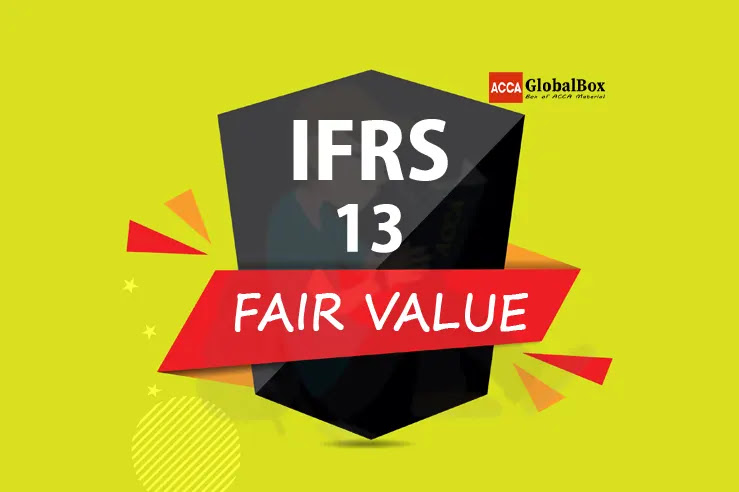What is IFRS 13 - Fair Value Measurement?
"Fair Value is the Price that would be received to sell an asset."
OR, "A Price that is Paid to Transfer a Liability in Orderly Transaction between the Market Participants at the measurement date.
Who are the Market Participants?
"Market Participants are those who are:- Willing (Not forced into the transaction) to buy or sell.
- Knowledgeable, About:
- 1. Condition of the Asset
- 2. Location of the Asset
- 3. Restriction to use the Asset
Restriction to use the Asset:
Often it happens who provides an asset OR sells an asset, Attached some conditions on the use of the Asset. For example,
Example 1: A Charity donates a Club to a School on the condition that 'This club will only be used for the football matches.
Example 2: A road in Pakistan that links PAKISTAN and IRAN has a condition imposed by the Government of Pakistan that 'This road will only be used to transfer the Petrol between PAKISTAN and IRAN.
What are the Markets?
"Markets are those in which transactions of buying, selling, or transferring of assets or liability take place."
Types and Definitions of the Markets
- Active Market:
- Principle Market:
- Most Advantageous Market:
-
A market in which transactions for the asset or liability take place with sufficient frequency and volume to provide pricing information on an ongoing basis.
-
Market with the highest number of transactions.
-
The Most advantageous market is the One that "Maximises the Net Amount received from selling an asset (or minimizes the amount paid to transfer a liability).
Let's discuss the Market with the example so you can get a better understanding of them.
Which one is Active Market?
| A | B | C |
| 8m transactions |
10m transactions |
12m transactions |
|
|
|
What if there is more than one active market? 🤔
| A | B | C | D |
| 8m transactions |
10m transactions |
12m transactions |
14m transactions |
|
|
If there is More Than One Active Market, in such circumstances, Choose the one that has the HIGHEST NUMBER OF TRANSACTIONS.
So, Market D. The "Principle Market" will be the Active Market.
But what if,
| C | D |
| 12m transactions |
14m transactions |
|
|
In this case, we will choose the "Most Advantageous Market" as Active Market.
"Most Advantageous Market" ---> That Maximises the Net Amount Received.
That is Market C (26) that is giving the Maximum Advantage.
Assumptions of IFRS 13 - Fair Value
Fair Value measurement assumes that the;- "Transactions take place in Principle Market". OR,
- In the absence of Principle Market, "Transactions take place in the Most Advantegeaous Market".
- In the case of Non-Financial Assets,
Fair Value Measurement will be taken as the "Highest and Best Use," which are Physically Possible, Legally Permissible, and Financially Feasible.
-
If the 'Best Use' cannot be identified, the 'Current Use of the Asset is considered to be the Best Use'.
- Transaction Costs (such as legal costs, broker fees, etc) will be taken into account while identifying the Most Advantageous Market. But, "will NOT be included in calculating Fair Value.
Example of, Highest and Best Use:
Ans. Commercial Use
So, we can say, The Agricultural and Commercial Use is Not Legally Possible. Only the Residential use is possible but, Is the Change in use Legally permissible? Does the Law allow us?
If yes, so we will be going to calculate the Fair Value according to the Residential use.
If no, we will be going to calculate the Fair Value according to the Agricultural use.
So, Repeat, In case of Non-Financial Assets,
-
"Fair Value Measurement will be taken as the "Highest and Best Possible Use," which are Physically Possible, Legally Permissible, and Financially Feasible."
There are different approaches to Fair Value.
Different Approaches to Fair Value.
- Market Approach
- Income Approach
- Cost Approach
Market Approach:
-
In Market Approach, the valuation is based on the Recent Market Condition.
Income Approach:
-
In Income Approach, the valuation is based on the Future Cashflows.
Cost Approach:
-
In Cost Approach, the valuation is based on the Replacement Cost.
After studying Approaches to Fair Value, Let's talk about the Fair Value Hierarchy.
Fair Value Hierarchy
Fair Value Hierarchy means "The sequence to know the Fair Value."
-
IFRS 13 - Fair Value seeks to increase consistency and comparability in Fair Value measurements and related disclosures through a 'Fair Value hierarchy'.
- Level 1 inputs
- Level 2 inputs
- Quoted Prices for Similar Assets in Active Market.
- Quoted Prices for Identical Assets in Less Active Market.
- Observable Inputs that are Not Prices. (such as interest rates)
- Level 3 inputs
-
Level 1 inputs are quoted prices for Identical Assets in Active Markets.
-
Level 2 inputs are Observable Prices that are Not Level 1 inputs.
-
Level 3 inputs are Unobservable.
-
This could include Cash or Profit forecasts using the Company's Own Data.
Some Important terms that are used in IFRS 13 and you may not be aware of.
Identical assets
-
Identical assets are defined as a group of similar assets that are not individually distinguishable other than by identifying numbers that they may bear.
Transport Cost
-
Cost to gain access to the market.
Transaction Cost
-
Cost to perform the transaction. (i.e. legal cost, broker fees, etc) and Transaction Cost will be ignored in measuring the Fair Value.
Replacement Cost
-
Replacement cost could be a Cost to Repurchase, OR Remanufacturing cost, OR Cost of the New Asset that will be Repurchased by selling the Current Asset, etc.
Good Luck 👍 and ENJOY! 😊



1 Comments
NBA Predictions Today Cbs | PlayerCasino.com leovegas leovegas クイーンカジノ クイーンカジノ 688mlb public consensus bets,bet365 betting tips for today
ReplyDelete